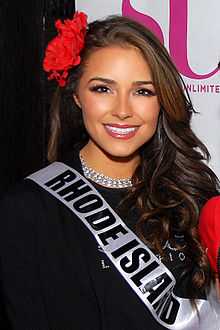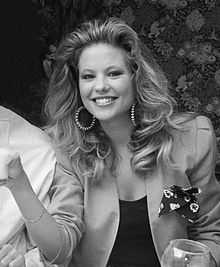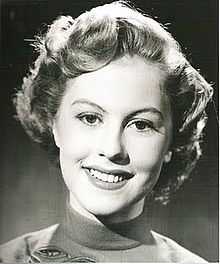Miss Universe
|
Logo of the Miss Universe pageant. | |
| Motto | Confidently Beautiful |
|---|---|
| Formation | 1952 |
| Type | Beauty Pageant |
| Headquarters | New York City |
| Location | |
Official language | English |
President | Paula Shugart |
Key people | Donald Trump |
| Website | www.missuniverse.com |
Miss Universe is an annual international beauty pageant that is run by the Miss Universe Organization. The pageant was founded in 1952 by the California clothing company Pacific Mills. The pageant became part of Kayser-Roth, and then Gulf+Western Industries, before being acquired by Donald Trump in 1996.[1][2]
The pageant is broadcast in the US on NBC and simulcast in Spanish on Univision, along with many international broadcasting channels. In 1998, Miss Universe changed its name from Miss Universe, Inc., to the Miss Universe Organization, and the headquarters moved from Los Angeles, California, to New York City in 1999.[3]
In 1998, the logo of Miss Universe – "the woman with stars" – was created, representing the beauty and responsibility of women around the Universe.
The current Miss Universe is Paulina Vega of Colombia who was crowned on 25 January 2015 in Doral, USA. Traditionally Miss Universe lives in New York City during her reign.
Miss Universe is part of the Big Four international beauty pageants.
History
The first use of the title "Miss Universe" was as part of International Pageant of Pulchritude which began in 1926. These events, the first international contests, lasted until 1935 when the Great Depression and other events preceding World War II led to their demise. This pageant had no direct relationship with the modern event.
Today's Miss Universe pageant was founded after Yolande Betbeze, the winner of the 1951 Miss America pageant, refused to pose in a swimsuit from its major sponsor, Catalina Swimwear. The brand's manufacturer Pacific Mills withdrew from Miss America and set up the Miss USA and Miss Universe contests. The first Miss Universe Pageant was held in Long Beach, California in 1952. It was won by Armi Kuusela from Finland, who gave up her title, though not officially, to get married, shortly before her year was completed.[4] Until 1958, the Miss Universe title, like that of Miss America, was dated by the year following the contest, so at the time Ms. Kuusela's title was Miss Universe 1953.
Miss Universe was founded by the Pacific Mills, a Californian-based clothing company. Since then, it is annually conducted with the Miss Universe Organization as the principal organizer. After gaining prominence from various pageant enthusiasts, the pageant became part of Kayser-Roth and then Gulf Western Industries, before being acquired by Donald Trump in 1996.[5]
The pageant was first televised in 1955. CBS-TV began broadcasting the combined Miss USA and Miss Universe pageants in 1960, and as separate contests in 1965, From 1955 to 1966 John Charles Daly hosted the pageant, Bob Barker from 1967 to 1987, Alan Thicke in 1988, John Forsythe in 1989, Dick Clark from 1990 to 1993 & Bob Goen from 1994 to 1996. In 2003, NBC-TV outbid the other networks for the TV rights.[6]
The "Miss Universe Organization" is based in New York and it is owned jointly by NBC Universal and Donald Trump. The current president is Paula Shugart.
Miss Universe's historical song, "You are my star" was the official song for the pageant from 1983 to 1995. It was sung by "Little Sisters", a group of young selected children from host country.[7]
In 2015, Univision signed a 5-year deal for the Spanish-language rights to the pageants, succeeding Telemundo.[8]
Competition formats
During the early years of the pageant, the delegates who made the first cut were announced after the preliminary competition. From 1965 to the present day, the semifinalists were not announced until the night of the main event. The semifinalists once again competed in evening gown and swimsuit and five finalists were announced. An interview portion was introduced in 1960 to decide the runners-up and the winner.
From 1959 to 1964 there were slight format changes. From 1959 through 1963 there was no cut to reach the five finalists. The runners-up and winner were called from the assembled 15 semifinalists. In 1965 the pageant returned to the original format of a cut to five finalists, and remained so until 1989. In 1969 a final question was posed to the last five contestants. The final question was an on-and-off feature of the pageant. In 1990 it had taken root, and with every pageant since the final contestants have had to answer a final question. In 1990 the pageant implemented major changes in the competition itself. Instead of five finalists, the field was reduced from ten semifinalists to six. Each contestant then randomly selected a judge and answered the question posed by the judge. After that, the field was narrowed down further to a final three. In 1998, the number of finalists was reduced to five, although there still was a cut to a final three. This continued until 2001, when the final five format was reinstated.
In the year 2000, the interview portion of the semifinal was dropped, and the contestants competed only in swimsuits and evening gowns, as in the early years of the pageant. In 2003, the number of semifinalists was increased to fifteen, with cuts made to ten, and then to five contestants. The final question varied, each coming from the final delegates themselves and the current Miss Universe. In 2006, twenty semifinalists were selected for the swimsuit competition, ten of whom went on to the evening gown competition. The five who passed that stage competed in an interview round, after which the runners-up and winner were announced. The 2007 contest followed a similar format, with fifteen contestants competing in the swimsuit stage. In 2011, for the first time, one of the sixteen semifinalists was selected exclusively by TV viewers via online voting. In the 2014 contest held in January 2015, a final question was chosen from thousands submitted by Facebook.[9]
The contest today
The Miss Universe Organization, a New York–based partnership between NBC and Donald Trump, has run the contest since June 20, 2002. Miss Universe 2014 was crowned on January 25, 2015 at Doral, Miami, USA.
Contestant selection
Local organizations that wish to select the Miss Universe contestant for their countries must submit bids to the Miss Universe Organization for that right. Occasionally, the traditional license holder for a particular country may lose its bid, as has happened in Italy and France.
Usually a country's candidate selection involves pageants in major cities, with the winners competing in a national pageant, but this does not always occur. For example, in 2000 Australia's national pageant was abolished as a relic of a bygone era, with Australian delegates instead chosen by a modeling agency. Such "castings" are generally discouraged by the Miss Universe Organization, which prefers national pageants that preserve an aura of respectability and competition. Despite being "cast", Miss Australia, Jennifer Hawkins, was chosen as Miss Universe 2004. Later that year, Australia resumed its national pageant and chose Michelle Guy as Miss Universe Australia 2005.
Some of the most successful national pageants in the last decade have been Venezuela, USA, Puerto Rico, Philippines, France which command consistently high interest and television ratings in their respective countries.[10] Recent arrivals in the pageant include China and Albania (2002), Vietnam, Georgia and Ethiopia (2004), Latvia (2005), Kazakhstan (2006), Tanzania (2007), Kosovo (2008), Gabon and Lithuania (2012) alongside Azerbaijan (2013); there have also been efforts to revive strong national pageants in South Africa, Canada, Spain, Japan and Latin America (especially Venezuela, Puerto Rico, Mexico, Colombia, and Brazil). Prior powerhouses are Finland, Germany and Sweden. England is the most successful nonwinning country with nine top-five positions. The current powerhouses that often make the semi-finals are: USA, Philippines, Venezuela, Brazil, France, Australia, Puerto Rico, Colombia, Russia, and South Africa.
The organization makes continual efforts to expand the pageant, but the participation of some countries such as Algeria has proven difficult due to cultural barriers to the swimsuit competition, while others such as Mozambique, Armenia and Nepal have balked at sending representatives due to the cost. As of 2014, only four countries have been present at every Miss Universe since its inception in 1952: Canada, France, Germany (East and West up to 1990), and the United States. Many European countries allow 17-year-old contestants to compete in their pageants, while Miss Universe's minimum age is 18, so national titleholders often have to be replaced by their runners-up. Miss Universe had previously prohibited transsexual applicants and age fabrication, but beginning in 2012, transgender women were allowed to compete, as long as they win their national pageants or are designated in their countries.[11]
Main pageant
The main Miss Universe Pageant is held over a two-week period in May and July. In the 1970s through the 1990s, the pageant was a month long. This allowed time for rehearsals, appearances, and the preliminary competition, with the winner being crowned by the previous year's titleholder during the final competition.
According to the organizers, the Miss Universe contest is more than a beauty pageant: women aspiring to become Miss Universe must be intelligent, well-mannered, and cultured. Often a candidate has lost because she did not have a good answer during the question responses rounds; although this section of competition has held less importance during recent pageants than it did in the twentieth century. Delegates also participate in swimsuit and evening gown competitions.
Currently, the final placement of the finalists is determined by a ranked vote, where each judge ranks each of the final three/five candidates, with the contestant posting the lowest cumulative score (thus often, but not necessarily always, the contestant with the most number one votes) becoming the winner. If there is a tie, the higher semifinal scores become decisive.
The winner is assigned a one-year contract with the Miss Universe Organization, going overseas to spread messages about the control of diseases, peace, and public awareness of AIDS. Since Donald Trump took over the pageant, the winner has been given the use of a Trump Tower apartment in New York City during her reign.[12] If the winner, for any reason, cannot fulfill her duties as Miss Universe, the 1st runner-up takes over.
Aside from the main winner and her runners-up, special awards are also given to the winners of the best National Costume, Miss Photogenic, and Miss Congeniality. The Miss Congeniality award is chosen by the delegates themselves. In recent years, Miss Photogenic has been chosen by popular internet vote (the winner used to be chosen by media personnel covering the event).
Final judgment
The competition for the Miss Universe title has seen many changes, although there have been several constants throughout its history. All the contestants compete in a preliminary round of judging (nowadays called the "Presentation Show") where the field is narrowed to a select number of semifinalists. This number has fluctuated over the years. The first Miss Universe pageant had ten semifinalists. For the next two years, the number of semifinalists grew to 16. In 1955, the number dropped to a stable 15, which remained through 1970. In 1971, the number was reduced to 12. That number was further reduced to 10 in 1984. This lasted until 2003, when the number of 15 was reinstated. In 2006, there were 20 semifinalists, the highest number ever. In 2007, the organization announced the Top 15 system would be back, which was also used in 2008 until 2010. In 2011, the system went through another change. Since then, are 16 semifinalists, 15 chosen by judges and one chosen by most popular by Internet votes.
In the early years, the contestants were judged in swimsuit and evening gown only. In later years, the contestants also competed in a preliminary interview round in a one-on-one meeting with each individual judge.
Crown
The Miss Universe crown used from 2002–2007 was designed by Mikimoto, the official jewelry sponsor of the Miss Universe Organization, and depicted the phoenix rising, signifying status, power and beauty. The crown has 500 diamonds of almost 30 carats (6.0 g), 120 South Sea and Akoya pearls, ranging in size from 3 to 18 mm diameter and is valued at $250,000. The Crown was designed for the pageant on Mikimoto Pearl Island in Japan with the Mikimoto crown and tiara being first used for Miss Universe 2002.[13]
The winner of the 2008 Miss Universe Pageant, which was broadcast from the Crown Convention Center in Nha Trang, Vietnam, will be crowned with the masterpiece which was designed by Rosalina Lydster of Jewelry by Rosalina and Ms. Dang Thi Kim Lien of CAO Fine Jewelry. The crown, valued at $120 thousand, is made of 18K white and yellow gold. It is composed of over 1,000 precious stones; including 555 white diamonds (30 carats), 375 cognac diamonds (14 carats), 10 smoky quartz crystals (20 carats) and 19 morganite gemstones (60 carats). The colors of the jewels chosen for the crown have great significance. The yellow luster of the gold represents the prosperous thriving economy in Vietnam. White, light pink and cognac are the main hues in the crown which represent inspiration and feeling. Each piece of the crown was designed to represent an important attribute of the Miss Universe Pageant. The curves of inlaid precious stones represent the strong development and potential of each country. The image of the crane (Lac Bird) symbolizes Vietnamese spirit and culture. The image of the heart represents unified breath, rhythm and vision, which are powerful internal forces that stress faith, hope and unity.
From 2009–2013, Diamond Nexus Labs made the Miss Universe crown. The crown is set with 1,371 gemstones, weighing a total of 416.09 carats (83.218 g). It contains 544.31 grams of 14k and 18k white gold as well as platinum. The crown features synthetic rubies to represent Miss Universe's HIV/AIDS education and awareness platform. Diamond Nexus Labs is the first ever eco-friendly Official Jeweler of Miss Universe and was selected as part of NBC Universal's "Green is Universal" initiative.[14][15]
Recent titleholders
| Year | Country | Miss Universe | National Title | Location | Number of Entrants |
| 2015 | TBA | TBA | TBA | TBA | TBA |
| 2014 | |
Paulina Vega | Miss Colombia | Doral, USA | 88 |
| 2013 | |
Gabriela Isler | Miss Venezuela | Moscow, Russia | 86 |
| 2012 | |
Olivia Culpo | Miss USA | Las Vegas, USA | 89 |
| 2011 | |
Leila Lopes | Miss Angola | São Paulo, Brazil | 89 |
| 2010 | |
Ximena Navarrete | Nuestra Belleza México | Las Vegas, USA | 83 |
Winners gallery
-

Miss Universe 2013
Gabriela Isler, Venezuela -

Miss Universe 2012
Olivia Culpo, USA -

Miss Universe 2011
Leila Lopes, Angola -

Miss Universe 2010
Ximena Navarrete,
Mexico -
Miss Universe 2009
Stefanía Fernández, Venezuela -

Miss Universe 2008
Dayana Mendoza, Venezuela -

Miss Universe 2007
Riyo Mori, Japan -

Miss Universe 2006
Zuleyka Rivera, Puerto Rico -

Miss Universe 2005
Natalie Glebova, Canada -

Miss Universe 2004
Jennifer Hawkins, Australia -

Miss Universe 2003
Amelia Vega, Dominican Republic -

Miss Universe 2002
Justine Pasek, Panama -

Miss Universe 2001
Denise Quiñones, Puerto Rico -

Miss Universe 2000
Lara Dutta, India -
Miss Universe 1997
Brook Lee, USA -

Miss Universe 1994
Sushmita Sen, India -

Miss Universe 1993
Dayanara Torres, Puerto Rico -

Miss Universe 1989
Angela Visser, Netherlands -
-2.jpg)
Miss Universe 1987
Cecilia Bolocco, Chile -

Miss Universe 1984
Yvonne Ryding, Sweden -

Miss Universe 1971
Georgina Rizk, Lebanon -

Miss Universe 1955
Hillevi Rombin, Sweden -

Miss Universe 1953
Christiane Martel, France -

Miss Universe 1952
Armi Kuusela, Finland
By number of wins
| Country | Titles | Winning Years |
| 8 | 1954, 1956, 1960, 1967, 1980, 1995, 1997, 2012 | |
| 7 | 1979, 1981, 1986, 1996, 2008, 2009, 2013 | |
| 5 | 1970, 1985, 1993, 2001, 2006 | |
| 3 | 1955, 1966, 1984 | |
| 2 | 1958, 2015 | |
| 1991, 2010 | ||
| 1959, 2007 | ||
| 1982, 2005 | ||
| 1972, 2004 | ||
| 1994, 2000 | ||
| 1977, 1998 | ||
| 1965, 1988 | ||
| 1952, 1975 | ||
| 1969, 1973 | ||
| 1963, 1968 | ||
| 1 | 2011 | |
| 2003 | ||
| 2002 (Successor) | ||
| 2002 (Dethroned) | ||
| 1999 | ||
| 1992 | ||
| 1990 | ||
| 1989 | ||
| 1987 | ||
| 1983 | ||
| 1978 | ||
| 1976 | ||
| 1974 | ||
| 1971 | ||
| 1964 | ||
| 1962 | ||
| 1961 | ||
| 1957 | ||
| 1953 |
Top 15 countries by tally
| Rank | Country | Miss Universe | 1st Runner-Up | 2nd Runner-Up | 3rd Runner-Up | 4th Runner-Up | Semifinalists | Total |
| 1 | |
8 | 9 | 6 | 1[18] | 5 | 29 | 58 |
| 2 | |
7 | 6 | 6 | 4 | 2 | 15 | 40 |
| 3 | |
5[19] | 1[20] | 2 | 1 | 3 | 8 | 20 |
| 4 | |
3 | 1 | 2 | 3 | 4 | 16 | 29 |
| 5 | |
2 | 5 | 1 | 2 | 5 | 18 | 33 |
| 6 | |
2 | 4 | 2 | 3 | 2 | 18 | 31 |
| 7 | |
2 | 3 | 5 | 1 | 1 | 7 | 19 |
| 8 | |
2 | 2 | 0 | 5 | 2 | 8 | 19 |
| 9 | |
2 | 1 | 3 | 2[21] | 2 | 7 | 17 |
| 10 | |
2[22] | 1[19] | 1 | 2 | 3 | 9 | 18 |
| 11 | |
2 | 1 | 1 | 1 | 1[23] | 16 | 22 |
| 12 | |
2[20] | 1 | 1 | 1 | 0 | 11 | 16 |
| 13 | |
2 | 0 | 1 | 2 | 2 | 10 | 17 |
| 14 | |
2 | 0 | 1 | 0 | 1 | 4 | 8 |
| 15 | |
2 | 0 | 1 | 0 | 0 | 4 | 7 |
Number of titles by continental region
| Continent | Titles | Countries/Territories |
| Americas | 35 | USA (8), Venezuela (7), Puerto Rico (5), Colombia, Mexico, Canada, Trinidad & Tobago, and Brazil (2), Dominican Republic, Panama*, Chile, Argentina, and Peru (1) |
| Europe | 12 | Sweden (3), Finland (2), Russia*, Norway, Netherlands, Spain, Greece, Germany, and France (1) |
| Asia | 10 | Japan, India, Thailand, and Philippines (2), Lebanon, and Israel (1) |
| Africa | 4 | South Africa, Namibia, Botswana, and Angola (1) |
| Oceania | 3 | Australia (2), New Zealand (1) |
- Russia was originally crowned Miss Universe 2002 but was dethroned 4 months into her reign. Panama was originally 1st Runner-Up assumed the title.
References
- ↑ "Miss Universe Pageant Defends Credibility Amid Criticism Show is Degrading, Unprofessional". Fox News. Retrieved 21 February 2015.
- ↑ "The Daily Star Web Edition Vol. 5 Num 5". thedailystar.net. Retrieved 21 February 2015.
- ↑ Foreman, Jonathan (January 18, 1999). "Mistress of the Universe". New York Post. Retrieved 24 February 2011.
- ↑ FUNFARE by Ricky Lo (June 28, 2006). "A misty-eyed look at Armi Kuusela, the 1st Miss Universe". philstar.com. The Philippine Star. Retrieved October 9, 2013.
- ↑ Prestigious Beauty Pageant (November 18, 2013). "Four Big Ships Dominate International Beauty Pageants". Prestigious Beauty Pageants. Retrieved June 15, 2014, 2013. Check date values in:
|accessdate=(help) - ↑ Jim Rutenberg (June 22, 2002). "Three Beauty Pageants Leaving CBS for NBC". nytimes.com (The New York Times). Retrieved October 8, 2013.
- ↑ "Miss Universe 1988 Evening Gown Competition". YouTube. 18 March 2011. Retrieved 21 February 2015.
- ↑ "Donald Trump: Miss Colombia must remain grounded". miamiherald. Retrieved 21 February 2015.
- ↑ Yahr, Emily (26 January 2015). "Miss Universe Pageant makes always-awkward Q&A segment worse with viewer questions". Washington Post. Retrieved 26 January 2015.
- ↑ "Miss Venezuela Parades Online". PR Newswire. September 18, 2002. Retrieved 23 October 2010.
The Miss Venezuela broadcast, which on average captures a whopping 74% of the Venezuelan television market share for Venevision, will also be available to users on demand.
- ↑ Dillon, Nancy (10 April 2012). "Transgender contestants can compete in Miss Universe". Daily News (New York).
- ↑ Felicia R. Lee (October 10, 2007). "Three Crowns Sharing One Apartment". nytimes.com (The New York Times). Retrieved October 9, 2013.
- ↑ "Mikimoto History Timeline". mikimotoamerica.com.
- ↑ "Connection to MISS UNIVERSE®". diamondnexus.com.
- ↑ "Diamond Nexus Labs Announced as The Official Jewelry of The Miss Universe Organization". redorbit.com (redOrbit). February 3, 2009. Retrieved October 8, 2013.
- ↑ Pageantopolis - Miss Universe
- ↑ Miss Universe Organization. "Past Miss Universe Winners". missuniverse.com. Retrieved 21 February 2015.
- ↑ "Unkissed Colombia girl is new Miss Universe". The Miami News. Associated Press. July 25, 1958. Retrieved 25 September 2011.
- ↑ 19.0 19.1 "Puerto Rico wins, faints". The Age (Melbourne). July 24, 2006. Retrieved 10 November 2010.
- ↑ 20.0 20.1 "Canada won the crown". El Universal. May 31, 2005. Retrieved 10 November 2010.
- ↑ "Miss Venezuela, Stefania Fernandez, Crowned Miss Universe". redorbit.com. PR Newswire. August 23, 2009. Retrieved 10 November 2010.
- ↑ "RP bet fails to advance to Top 15 in Miss Universe 2007". business.inquirer.net. Philippine Daily Inquirer. May 29, 2007. Retrieved October 9, 2013.
- ↑ "Puerto Rican beauty wins Miss Universe crown". Associated Press. May 12, 2001. Retrieved 10 November 2010.
In second place was Miss Greece, 22-year-old Evelina Papantoniou and in third place was Miss USA, 24-year-old Kandace Krueger. Miss Venezuela, 18-year-old Eva Ekvall was third runner-up and Miss India, 22-year-old Celina Jaitley was named fourth runner-up. The five semifinalists who were earlier eliminated in the pageant were Miss Spain, Eva Siso Casals; Miss Nigeria, Agbani Darego...
External links
| ||||||||||||||||||||||||||||||||||||||||


